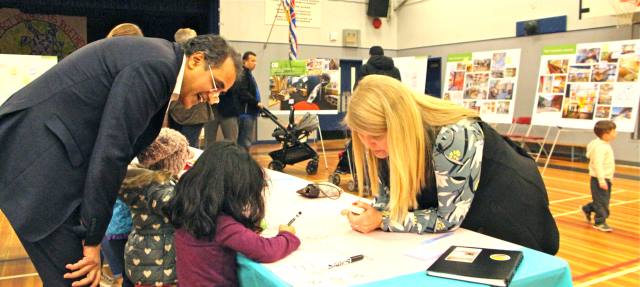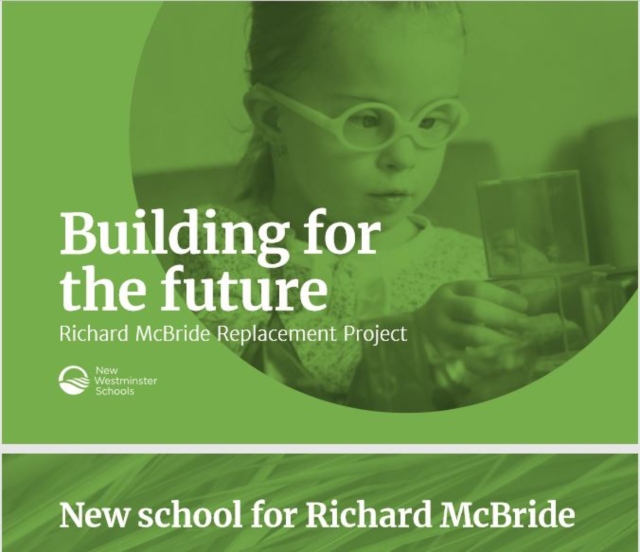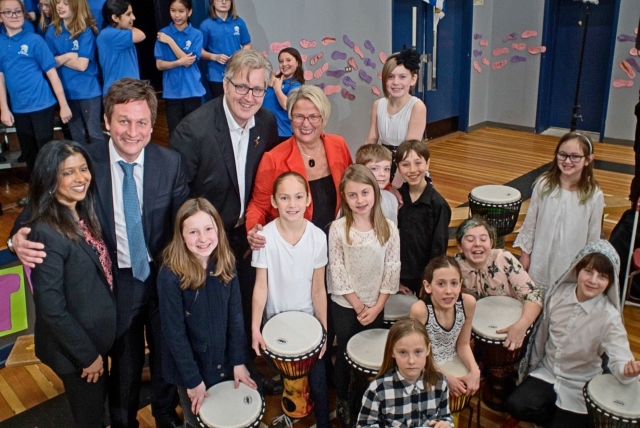Next steps for a new Richard McBride elementary school…

Tony Gill, Project Architect for a new Richard McBride elementary school, was on hand with Principal Kathleen Chad to help answer questions during a public consultation session in December.
Public Consultation…
The public will soon have a chance to see draft designs and artists’ renderings of what a new school for Richard McBride elementary will look like, thanks to the input of parents, staff and the community.
Architects at IBI Architectural Group will be ready to present their drafts at a second public consultation event scheduled for spring. The $22.6 million seismic replacement for the 90-year-old structure will provide students with a safe, modern school to learn and thrive in. Completion is slated for 2021.
 The first round of public consultation included an open house at the school on December 5, 2018, welcoming 75 parents, neighbours and community members. Together, they provided more than 320 written comments.
The first round of public consultation included an open house at the school on December 5, 2018, welcoming 75 parents, neighbours and community members. Together, they provided more than 320 written comments.
Consultation also included feedback from 54 participants provided through online and hard copy surveys.
Guiding Principles
The feedback session and public surveys were focused on a set of Guiding Principles developed by the Richard McBride Replacement Project Steering Committee, featuring the district’s senior leadership representatives and the Principal and Vice-Principal of Richard McBride Elementary School.
Development of the guiding principles also incorporated input from staff and parent representatives, and was supported by the Board of Education.
The following principles formed the basis of the open house event and public survey:
- Build a school that will support the learning environment.
- Develop a sustainable design that will minimize impacts on the environment.
- Develop a design with an emphasis on healthy students and staff.
- Honour the historical and cultural significance of New Westminster.
- Create adaptive spaces that consider the role of rapidly changing technology in the ways students learn.
- Create opportunities for school and community engagement.
- Create indoor and outdoor learning spaces.
- Make teaching and learning spaces visible.
- Design a school that inspires and nourishes creativity.
What We Heard
The majority of participants strongly agreed with the guiding principles and provided specific suggestions in support of key initiatives such as modern learning spaces, outdoor spaces, environmental sustainability, and enhancement of student well-being.
 Many participants issued overarching calls to ensure a new school design incorporates the need for future growth, respects the unique view of the Fraser River as an inspiration for place-based learning, and meets the needs for accessibility for all children.
Many participants issued overarching calls to ensure a new school design incorporates the need for future growth, respects the unique view of the Fraser River as an inspiration for place-based learning, and meets the needs for accessibility for all children.
Some suggestions ranged broadly from solar panels and outdoor amphitheatres to geothermal heating, a barbecue for potlatches, a living wall, hockey boxes, kitchens with industrial sinks, storage (and more storage), and underground parking.
Most comments touched on some of the following issues, including those not necessarily identified in the guiding principles:
- Learning space: The majority of comments called for a modern school that meets the needs of 21st century student learning – i.e.: larger, flexible spaces for collaborative teaching and learning (pods, removable walls, sliding glass doors, innovative use of corridor space); multi-purpose spaces for the performing and visual arts and physical activity; support for full technology (projector screens, age-appropriate technology including coding and STEM toys), makerspaces, and a learning commons. Several wanted to see gender-neutral washroom options.
- Student needs: accessibility and safety were two key concerns, with calls for wheelchair accessible outdoor space, playgrounds, and washrooms for all students. Participants also wanted to see mental health zones and sensory spaces to support student health and well-being as well as children with complex needs. Suggestions included areas for students to socialize (a cafeteria or dining room) and safe and comfortable quiet spaces for those who can’t be in a classroom for a period of time. Several participants expressed some concern about the extensive use of glass as distracting for students; comments also noted the need for landscaping that addresses ‘dead space’ between the school and the hill to improve the ability to monitor for student safety.
- Parking and drop-off issues: Some participants wanted to see safe drop-off zones, increased safety for walking families, safer crossings at Richmond, School and Archer Streets, changes to parking regulations to limit hospital and transit parking in the area, and a ‘drive-to-five’ approach that takes students to locations within a five-minute walking distance of the school to circumvent congestion. Several respondents emphasized support for active transportation such as bicycle use.
- Community concerns and aspirations: Several community members expressed concern that their views would be impeded by a new school, depending on its location and design. Others welcomed a role for community involvement in gardens and sports activities, with several voicing support for the StrongStart program and before and after school care. Half-a-dozen participants wanted to see incorporation of a heritage facade; another urged a final design that balances ” modern spaces with a historical appearance.” Still another participant called for ‘good design first’ above addressing historical and cultural significance.
How input will be considered
Public feedback, along with technical, environmental and financial considerations, will inform the final design for the replacement for Richard McBride Elementary school. The steering committee and the design team (IBI Architectural Group) will take bids on a design this coming fall.

On March 9, 2018, the BC Ministry of Education announced a $22.6 million seismic replacement for 90-year-old Richard McBride Elementary School to provide students with a safe, modern school to learn and thrive in. Completion is slated for 2021.
